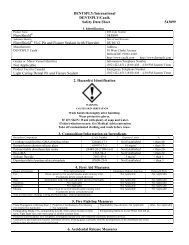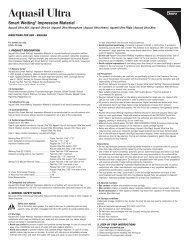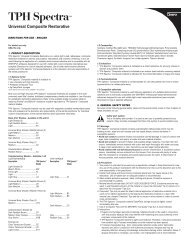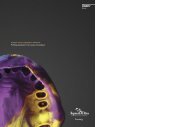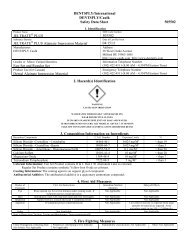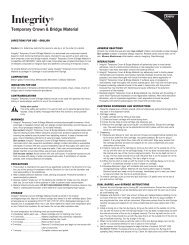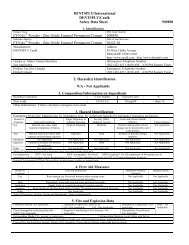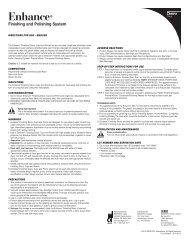Indirect and Direct Restorative Protocols - Caulk
Indirect and Direct Restorative Protocols - Caulk
Indirect and Direct Restorative Protocols - Caulk
You also want an ePaper? Increase the reach of your titles
YUMPU automatically turns print PDFs into web optimized ePapers that Google loves.
››<br />
“By combining the use of the B4 Surface Optimizer <strong>and</strong><br />
the Aquasil Ultra Smart Wetting Impression Material,<br />
even ultra thin margins are maintained, allowing multiple<br />
pours for increased communication with the laboratory.”<br />
Robert G. Ritter, DMD<br />
Private practice, Palm Beach Gardens, FL.<br />
Table. Clinical Considerations for Impression Capture<br />
Clinical Requisite<br />
Adequate<br />
gingival health<br />
Biologic space<br />
requirement<br />
Rationale<br />
Gingival inflammation may complicate hemostasis <strong>and</strong> moisture control; gingival<br />
assessment <strong>and</strong> transfer can also be compromised. Impressions should not be taken<br />
if inflammation cannot be controlled.<br />
Approximately 2 mm of distance is required between the restoration’s finish line <strong>and</strong> the<br />
alveolar crest to maintain the crestal bone level in comparison to the gingival margin.<br />
Appropriate<br />
tissue retraction<br />
Regardless of the specific technique selected, it is advisable to create a lateral space of<br />
approximately 1 mm <strong>and</strong> an apical extension beyond the finish line of approximately 1 mm.<br />
Bilateral cheek<br />
retraction<br />
Patients may bite asymmetrically if the cheek is retracted on one side only as the<br />
impression is taken; this technique may help to ensure proper centric occlusion is captured.<br />
Proper patient<br />
education<br />
Once the tray is seated, patients should refrain from any movements that could shift the<br />
position of the tray, thereby distorting the impression maintained.<br />
Figure 3. The impression is made using Aquasil Ultra Smart Wetting ®<br />
Impression Material (DENTSPLY <strong>Caulk</strong>, Milford, DE). Note its precise<br />
marginal detail.<br />
Figure 4. A centric bite registration should be captured for precise<br />
laboratory communication.<br />
12



